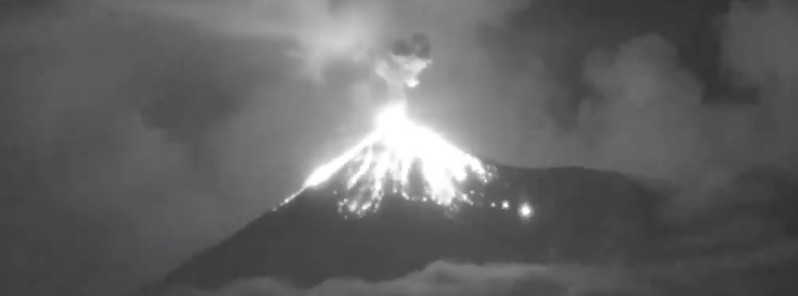Frequent explosions at Fuego volcano, lahar warning issued, Guatemala

Frequent explosions continue at Fuego volcano, Guatemala accompanied by ash emissions up to 4.8 km (15 600 feet) a.s.l., ashfall in nearby communities and lahars.
In 24 hours to 14:20 LT on October 6, the Fuego volcano observatory reported white fumarole with a height of 4.5 km (14 764 feet) above sea level, 6 to 10 explosions per hour, accompanied by columns of gray ash 4.6 to 4.8 km (15 100 to 15 700 feet) above sea level, drifting south and southwest.
A weak to moderate lahar was reported at 14:10 LT in the Ceniza canyon, located on the southwest flank of the volcano, which is a tributary to the Achiguate river.
Lahars can transport tree branches and volcanic material such as ash and blocks of 1 to 2 m (3.3 – 6.6 feet) in diameter, CONRED said, urging people and tourists not to stay in or near the canyons.
If the rains persist, the generation of more lahars in this or other canyons is possible.
In addition, residents should be aware that road traffic could be affected on the routes where lahars descend.
October 6, 2020, Explosions ~ Volcan De Fuego, Guatemala ~ Via Crelosa #volcano #volcandefuego #fuego #guatemala Visit Crelosa: https://t.co/8Pe3NhmTm9 pic.twitter.com/0GX904FDM0
— Volcano Time-Lapse (@DavidHe11952876) October 7, 2020
In 24 hours to 07:47 LT on October 7, observatory monitoring the volcano reported weak gray fumarole and weak, moderate, and strong explosions at a rate of 5 to 8 per hour.
Gray ash columns rose to a height of 4.5 to 4.7 km (14 700 – 15 400 feet) above sea level, dispersing in a west and southwest direction.
Ashfall was reported in communities such as Panimaché I, La Rochela, Morelia, Sangre de Cristo, El Porvenir and others in that direction.
Geological summary
Volcán Fuego, one of Central America's most active volcanoes, is one of three large stratovolcanoes overlooking Guatemala's former capital, Antigua. The scarp of an older edifice, Meseta, lies between 3 763 m (12 345 feet) high Fuego and its twin volcano to the north, Acatenango.
Construction of Meseta dates back to about 230 000 years and continued until the late Pleistocene or early Holocene. The collapse of Meseta may have produced the massive Escuintla debris-avalanche deposit, which extends about 50 km (31 miles) onto the Pacific coastal plain.
The growth of the modern Fuego volcano followed, continuing the southward migration of volcanism that began at Acatenango. In contrast to the mostly andesitic Acatenango, eruptions at Fuego have become more mafic with time, and most historical activity has produced basaltic rocks.
Frequent vigorous historical eruptions have been recorded since the onset of the Spanish era in 1524, and have produced major ashfalls, along with occasional pyroclastic flows and lava flows. (GVP)
Featured image credit: IDIS

Commenting rules and guidelines
We value the thoughts and opinions of our readers and welcome healthy discussions on our website. In order to maintain a respectful and positive community, we ask that all commenters follow these rules:
We reserve the right to remove any comments that violate these rules. By commenting on our website, you agree to abide by these guidelines. Thank you for helping to create a positive and welcoming environment for all.